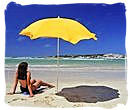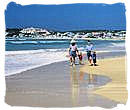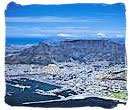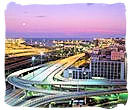 |
|||||||||||||
South African Music, |
|||||||||||||
| The beginning |
| The new jazz |
| Jazz in exile |
| Jazz at home |
| Mbaqanga jazz |
| Missionaries and choirs |
| Minstrels |
| Marabi |
| Kwela |
| Pop, rock and crossover |
| Bubblegum, kwaito, alternative Afrikaners |
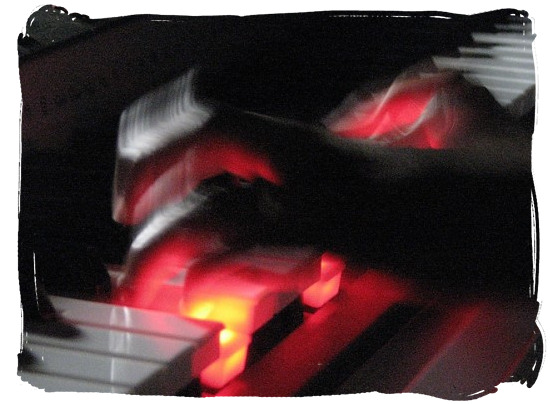
Music on fire
South African Music, a Fusion of South Africa Music Cultures, copyright © South African tourism
The beginning,…
Since early colonial times, South African music has evolved out of the blending of local ideas and forms with those imported from elsewhere, giving it the unmistakable flavour of the country. In the Dutch colonial era, from the 17th century on, indigenous South African people and slaves imported from the east adapted Western musical instruments and ideas.
The Khoi-Khoi, for instance, developed the Ramkie, a guitar with three or four strings, and used it to blend Khoi and Western folk songs. They also used the Mamokhorong, an indigenous single-string violin, in their own music-making and in the dances of the colonial centre, Cape Town.
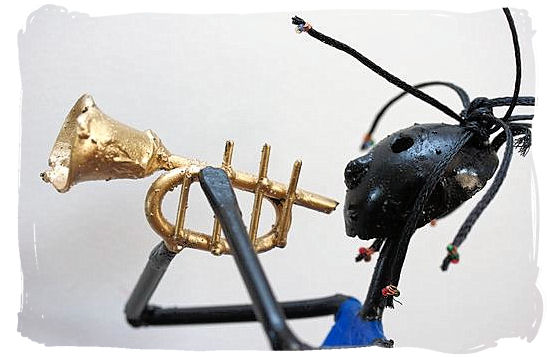
The trumpet player
South African Music, a Fusion of South Africa Music Cultures, Photograph: Chubby Bat
Western music was played by slave orchestras and travelling musicians of mixed descent, moving around the colony, entertaining at dances and other functions, a tradition that continued into the era of British domination after 1806.
Coloured bands of musicians began parading through the streets of Cape Town in the early 1820s, a tradition that was given added impetus by the travelling minstrel shows of the 1880s and has continued to the present day with the Minstrel Carnival held in Cape Town every New Year.
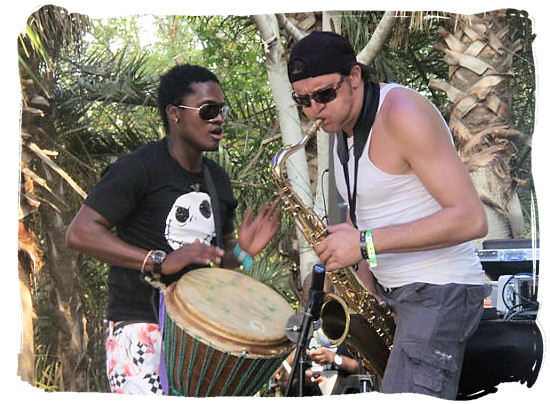
Fusion of music
South African Music, a Fusion of South Africa Music Cultures
< Top of page
Missionaries and choirs,…
In the late 1800s, early African composers such as John Knox Bokwe began composing hymns that drew on traditional Xhosa harmonic patterns.
The influence of both missionary music and American spirituals stimulated the development of the gospel music genre in South Africa. Gospel, in its many forms, is one of South Africa's best-selling genres, with artists regularly achieving gold and platinum sales.
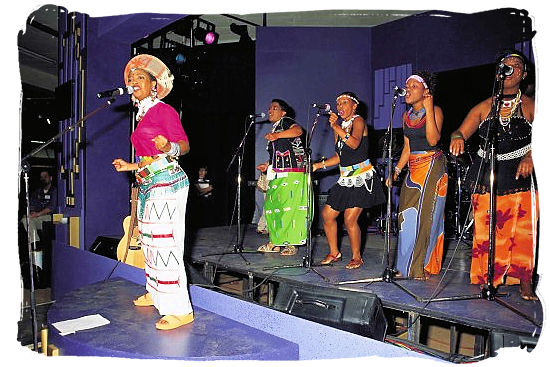
Singing a Capella
South African Music, a Fusion of South Africa Music Cultures, copyright © South African tourism
The missionary emphasis on choirs, combined with the traditional South African vocal music and other elements, also gave rise to a mode of a cappella singing that blended the style of Western hymns with indigenous harmonies. This tradition has endured in the oldest traditional music in South Africa, Isicathamiya, of which Ladysmith Black Mambazo are the best-known exponents.
African instruments such as the mouth bow and, later, the mbira from Zimbabwe, and drums and xylophones from Mozambique, began to find a place in the traditions of South African music. Still later, Western instruments such as the concertina and guitar were integrated into indigenous musical styles, contributing for instance, to the Zulu mode of Maskhandi music.
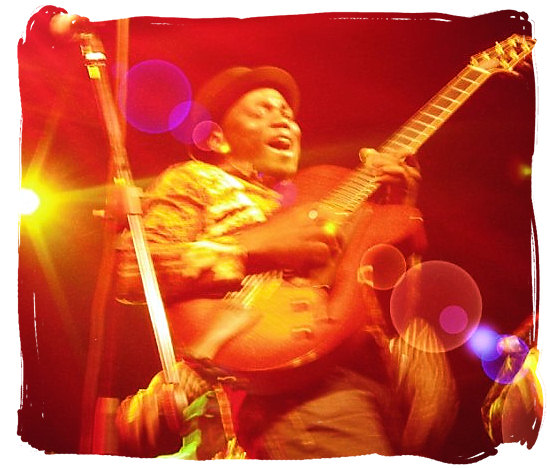
Pitching the guitar
South African Music, a Fusion of South Africa Music Cultures
< Top of page
Minstrels,…
In the mid 1800s travelling minstrel shows began to visit South Africa. At first these minstrels were white performers in "black-face" but by the 1860s genuine black American minstrel troupes such as Orpheus McAdoo and the Virginia Jubilee Singers began to tour South Africa influencing locals to form similar choirs.
This minstrel tradition, joined with other forms, contributed to the development of isicathamiya, which had its first international hit in 1939 with Mbube by Solomon Linda and the Evening Birds. This remarkable song has been reworked innumerable times, most notably as Pete Seeger's hit Wimoweh and the international classic The Lion Sleeps Tonight.
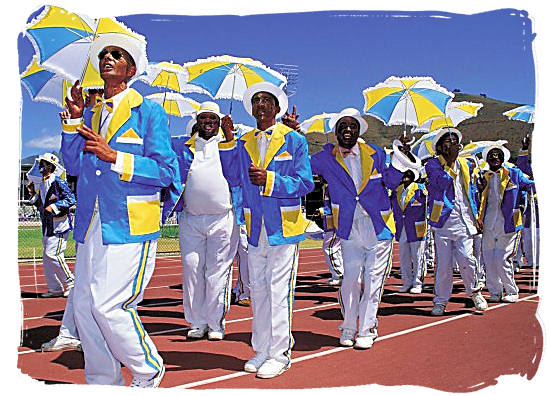
Cape Minstrels on the march
South African Music, a Fusion of South Africa Music Cultures, copyright © South African tourism
< Top of page
Marabi,…
In the early 20th century, new forms of hybrid music began to arise among the increasingly urbanised black population of mining centres such as Johannesburg.
Marabi, a keyboard style of music played on pedal organs, became popular in the ghettos of the city. This new sound, basically intended to draw people into the Shebeens (illegal taverns), had deep roots in the African tradition and smacked of influences of American ragtime and the blues.
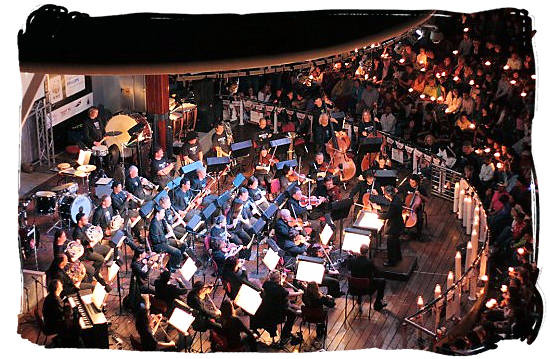
Music is in the Air at the Victoria Waterfront in Cape Town with the Cape Philharmonic Orchestra
South African Music, a Fusion of South Africa Music Cultures, copyright © South African tourism
Associated with illegal liquor dens and vices such as prostitution, the early Marabi musicians formed a kind of underground musical culture and were not recorded. However, the lilting melodies and loping rhythms of Marabi did find their way into the sounds of the bigger dance bands.
These bands achieved considerable fame in the 1930s and 1940s, winning huge audiences among both black and white South Africans and so Marabi gained immense popularity from the 1930s onward. A truly indigenous South African musical language was being born.
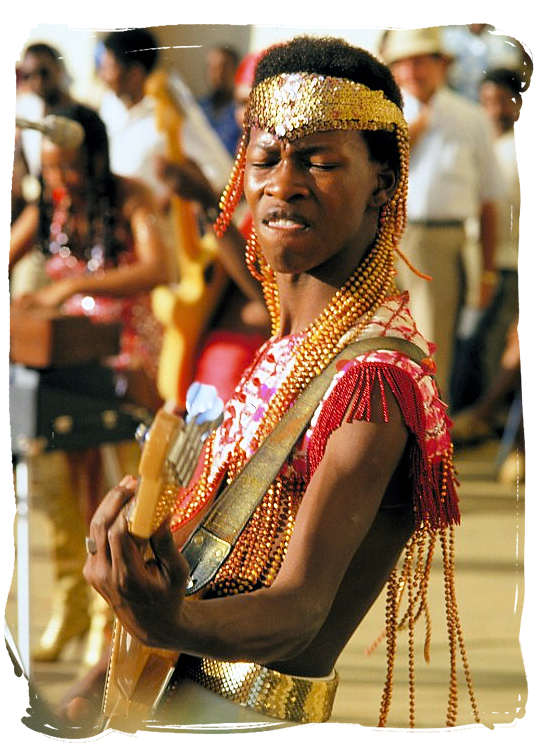
Passionate guitar play
South African Music, a Fusion of South Africa Music Cultures, copyright © South African tourism
< Top of page
Kwela,…
One of the offshoots of the Marabi sound was Kwela, which brought South African music to international prominence in the 1950s. Named for the Zulu word meaning "climb on" - and a reference to police vans, known as "kwela-kwela" in township slang, Kwela music was taken up by street performers in the shanty towns.
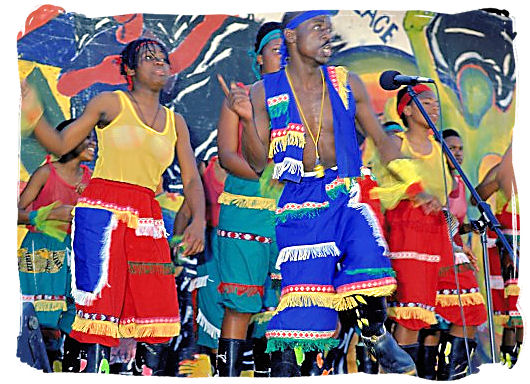
Rainbow music
South African Music, a Fusion of South Africa Music Cultures, copyright © South African tourism
The instrument of Kwela was the pennywhistle, which was both cheap and simple and could be used either solo or in an ensemble. Its popularity was perhaps because flutes of different kinds had long been traditional instruments among the peoples of northern South Africa. The pennywhistle thus enabled the swift adaptation of folk tunes into the new marabi-inflected idiom.
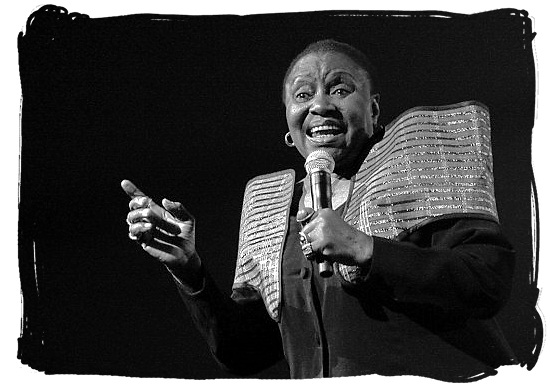
Miriam Makeba
South African Music, a Fusion of South Africa Music Cultures, copyright © South African tourism
< Top of page
Mbaqanga jazz,…
Propelled in part by the hunger of the vast urban proletariat for entertainment, various strains of South African music were pouring themselves into an exciting melting pot of ideas and forms by the middle of the 1950s.
A key area in this growth was the township of Sophiatown in Johannesburg, which had grown since the 1930s into a seething cauldron of the new urban lifestyles of black city dwellers. The suburb attracted the most adventurous performers of the new musical forms and became a hotbed of the rapidly developing black musical culture.
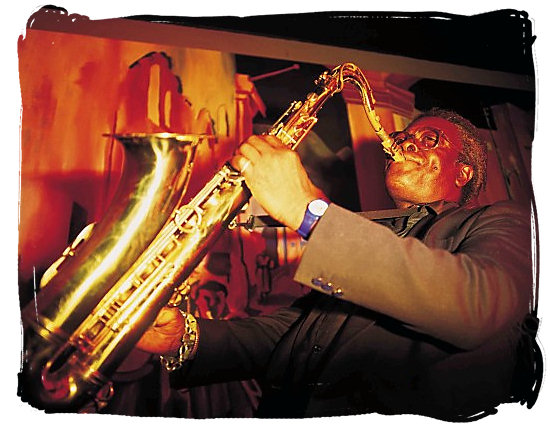
The magic of Jazz
South African Music, a Fusion of South Africa Music Cultures, copyright © South African tourism
The old strains of Marabi and Kwela had begun to coalesce into what is broadly known as Mbaqanga, a form of African-inflected jazz. Singing stars such as Miriam Makeba, Dolly Rathebe and Letta Mbulu gained fanatical followings.
The cyclic structure of Marabi met with traditional dance styles such as the Zulu indlamu, which in turn gave a notably African rhythmic impulse to the music, making it quite irresistible to its new audiences.
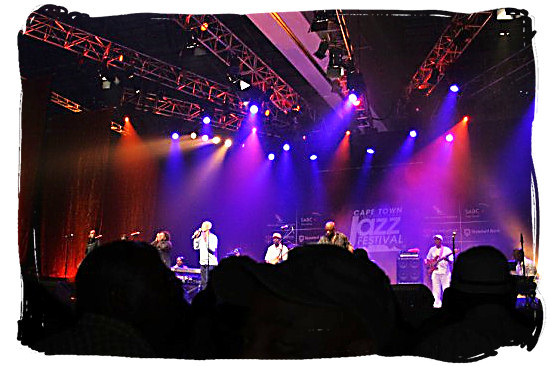
Jazz festival in full swing
South African Music, a Fusion of South Africa Music Cultures
< Top of page
The new jazz,…
The cross-cultural influences that had been brewed in Sophiatown continued to inspire musicians of all races in the years that followed. Just as American ragtime and swing had inspired earlier jazz forms, so the new post-war American style of bebop had begun to filter through to South African musicians.
In 1955, the most progressive jazz-lovers of Sophiatown had formed the Sophiatown Modern Jazz Club, propagating the sounds of bebop. From their meetings grew South Africa's first bebop band, the Jazz Epistles, whose earliest membership was a roll-call of musicians destined to shape South African jazz from then on.
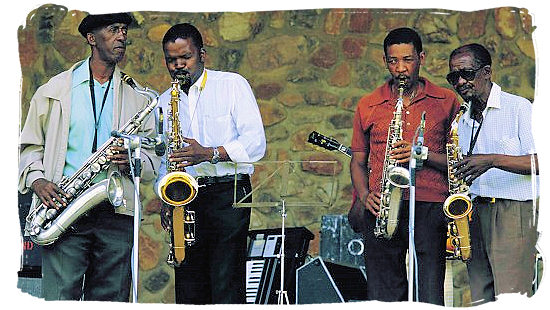
Saxophone is king
South African Music, a Fusion of South Africa Music Cultures, copyright © South African tourism
King Kong, a jazz-opera telling the tale of black South African boxer Ezekiel Dlamini, became a hit and toured overseas. Leading South African musicians such as Miriam Makeba, the Manhattan Brothers and Kippie Moeketsi starred in the show. Many found the freedom outside the country an irresistible lure, and remained in exile there.
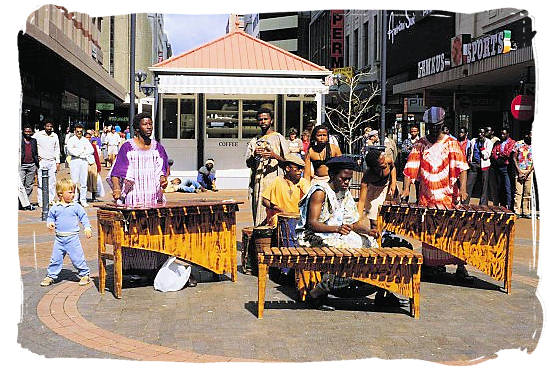
Music in the street
South African Music, a Fusion of South Africa Music Cultures copyright © South African tourism
< Top of page
Jazz in exile,…
Abdullah Ibrahim is undoubtedly a towering figure in South African music, a man who brought together all its traditions with a deeply felt understanding of American jazz, from the orchestral richness of Duke Ellington's compositions for big band to the groundbreaking innovations of Ornette Coleman and the 1960s avant-garde.
Ibrahim's old collaborator, the trumpeter Hugh Masekela, also had a glittering career outside South Africa. He played his way through the vibrant Sophiatown scene and to Britain with King Kong, to find himself in New York in the early 1960s. He reconnected with South African players when he set up a mobile studio in Botswana in the 1980s, just over the South African border.

Saxophone at full blast
South African Music, a Fusion of South Africa Music Cultures, copyright © South African tourism
Also pursuing the expansion of South African jazz into new realms, though in Britain, was the band the Blue Notes. Having made a name for themselves in South Africa in the early 1960s, this dymanic, adventurous group, led by pianist Chris MacGregor, left for Britain in the late 1960s and stayed there. There they became became an essential part of the European jazz avant-garde, carrying the African influence far beyond its shores.
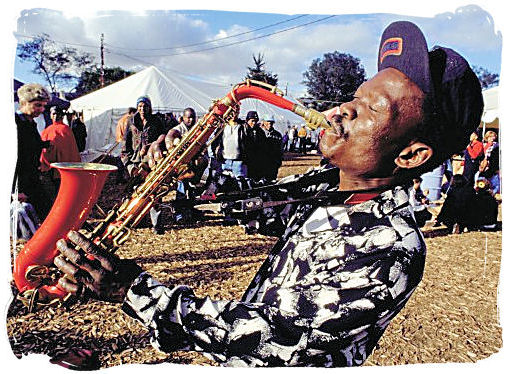
Saxophone player at the Grahams town festival
South African Music, a Fusion of South Africa Music Cultures
< Top of page
Jazz at home,…
One key South African jazz performer, Philip Tabane, a guitarist who brought together the deepest, oldest polyrhythmic traditions with the freest jazz-based improvisation, kept the musical flame burning in South Africa.
From the early 1960s until today, Tabane has produced some of South Africa's most interesting and adventurous sounds. Long after democracy, Tabane has helped shape and inspire the musical careers of many musicians in South Africa. Tabane has also done collaborations with house music group Revolution.
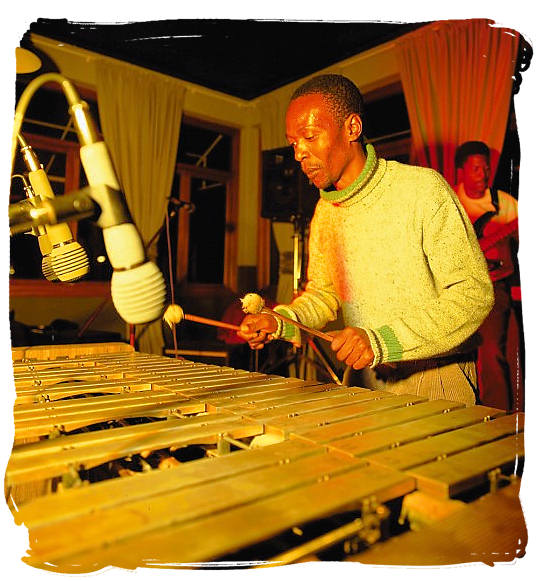
The Xylophone is brought to life
South African Music, a Fusion of South Africa Music Cultures, copyright © South African tourism
Jazz continued to be played in South Africa during the years of severe repression, with groups such as the African Jazz Pioneers and singers such as Abigail Kubheka and Thandi Klaasen keeping alive the mbaqanga-jazz tradition that had enlivened Sophiatown.
The 1980s saw the appearance of Afro-jazz bands such as Sakhile and Bayete, marrying the sounds of American fusion and ancient African patterns, to considerable commercial success.
Others such as the band Tananas took the idea of instrumental music into the direction of what became known as "world music", creating a sound that crosses borders with a mix of African, South American and other styles.
More recently, a blend of contemporary and jazz music has taken South Africa by storm with young women musicians like Simphiwe Dana, Zamajobe Sithole and Siphokazi Maraqana adding some spice to the way people look at jazz.
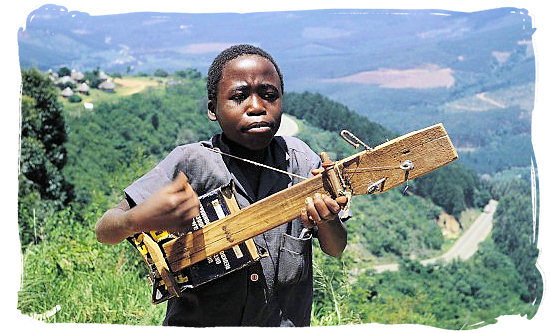
Me and my guitar
South African Music, a Fusion of South Africa Music Cultures, copyright © South African tourism
< Top of page
Pop, rock and crossover,…
From the 1960s onward, more and more white rockers and pop groups appeared to appeal to white audiences in a segregated South Africa.
Among the most successful bands from South Africa are “Four Jacks and a Jill”, who had their first number one hit with "Timothy" in 1967. Within the next year, they had an international hit on their hands with "Master Jack", which reached number eight in the US and number one in Canada, Malaysia, New Zealand and Australia.
In the mid-1970s, the "boy band" hit South Africa in the form of Rabbitt, four young men who kicked off their career with a cover of a Jethro Tull song and, in a singularly daring move, posed naked on their second album cover ("A Croak and a Grunt in the Night").
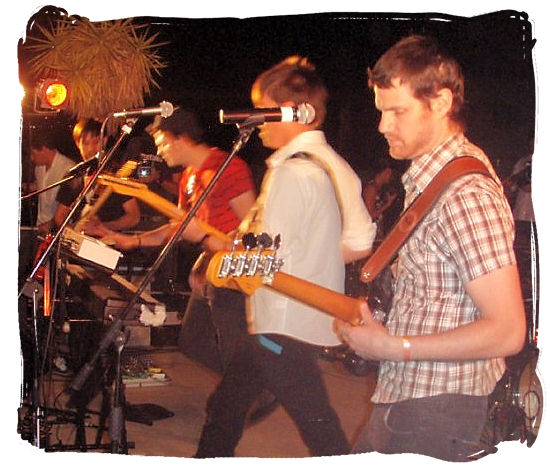
The power of Rock ‘n Roll
South African Music, a Fusion of South Africa Music Cultures, copyright © REPRESENT.CO.ZA
As the 1970s drew to a close, however, the mood began to change and the echoes of Britain's angry working-class punk movement began to reach South Africa. Springs, a poorer white area on the outskirts of Johannesburg, proved to be the breeding ground of a new generation of rockers who were disillusioned about South Africa's repressive white regime.
At the same time, a crossover was beginning to happen between black and white musicians. Johnny Clegg, a social anthropologist who learnt so much about Zulu music and dance that he formed his own group Juluka with Sipho Mchunu, led the charge.
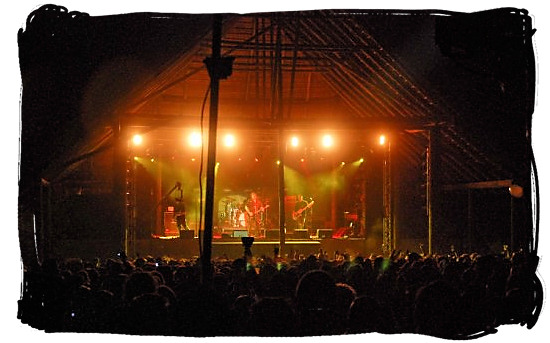
On stage in the African bushveld
South African Music, a Fusion of South Africa Music Cultures
Juluka's ability to mix traditional Zulu music with white pop and folk was in itself a challenge to the racial boundaries the apartheid regime attempted to erect between blacks and whites.
Crossover music is still alive and well in the new millennium, with the best example possibly the band Freshlyground, who burst onto the scene in 2002. Freshlyground adds violin and flute to the familiar band instrumentation of bass, drums, keys and guitar, and sometimes throw in the mbira, a traditional African “thumb piano”, and sax.
Their song “Doo Bee Doo”, from the 2005 album Nomvula, has become something of a happy anthem for a new South Africa untroubled by its difficult past. The album itself sold 150 000 copies.
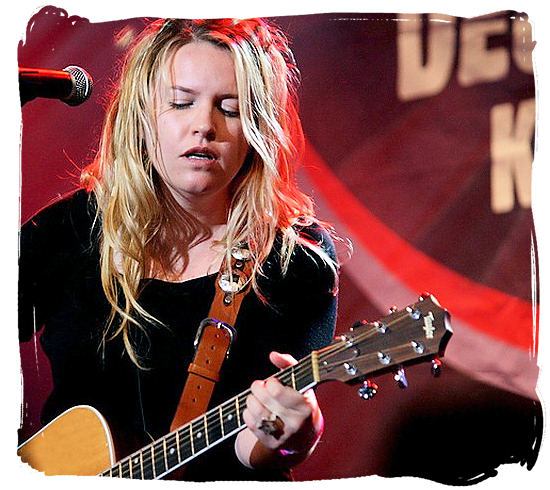
Karen Zoid
South African Music, a Fusion of South Africa Music Cultures
< Top of page
Bubblegum, kwaito and alternative Afrikaners,…
While white rockers expressed their angst to largely white audiences during the 1980s, the black townships were held in thrall by what came to be called "bubblegum" - bright, light dance pop influenced by American disco as much as by the heritage of mbaqanga.
Forebears of this style were groups such as the Soul Brothers, who had massive hits with their soulful pop, while artists such as Brenda Fassie, Chicco Twala and Yvonne Chaka Chaka drew huge audiences for their brand of township dance music.
Up until her death in 2004, Brenda Fassie was perhaps the most controversial and the best-known figure in township pop, having had a huge hit in 1985 with "Weekend Special" before embarking on a decade of high living that would have put the Rolling Stones to shame.
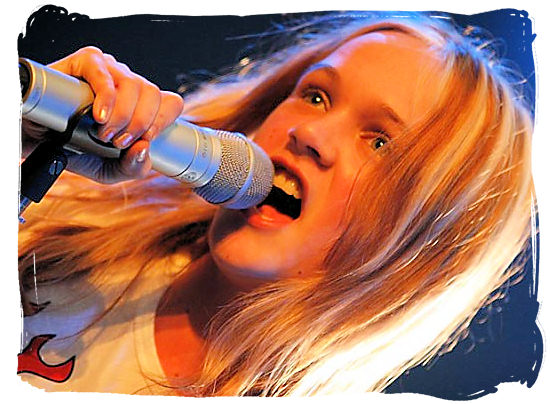
Young talent in action
South African Music, a Fusion of South Africa Music Cultures
In the 1990s, a new style of township music, kwaito, grabbed the attention and the hearts of South Africa's black youth. Just as township "bubblegum" had drawn on American disco, so kwaito put an African spin on the international dance music of the 1990s, a genre loosely referred to as house music. Young South African music-makers gave it a homemade twist but with echoes of hip-hop and rap.
In the early 2000s, a revolution in South African music was taking place - a hip-hop music culture was taking place with youth stations like Yfm in the fore-front in promoting this genre.
South African hip-hop has left an indelible mark on the music scene and this genre continues to grow with artists such as Tuks, Zubz, Hip-Hop Pantsula, Pro-Kid, Zulu Boy and Proverb taking took up the challenge to blend the thumping beats of US hip-hop blended with Afro-pop music.
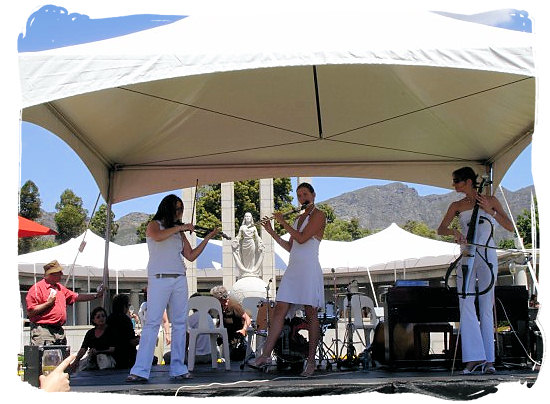
Sunshine music
South African Music, a Fusion of South Africa Music Cultures
The years since democracy have seen the re-emergence of alternative Afrikaans music, with young Afrikaners reclaiming and taking pride in a culture free of the guilt of apartheid - the "Karen Zoid generation".
Often eccentric and quirky, this music ranges from the rough and raw sound of Fokofpolisiekar to the classic rock of Arno Carstens and the gentler music Chris Chameleon. More mainstream Afrikaans music is also widely popular, and includes artists such as Dozi, Steve Hofmeyer, Patricia Lewis, Bok van Blerk, Theuns Jordaan and Kurt Darren, to name but a few.
Top of Page
